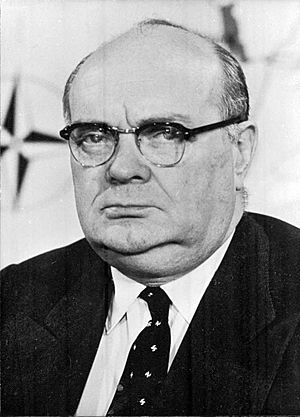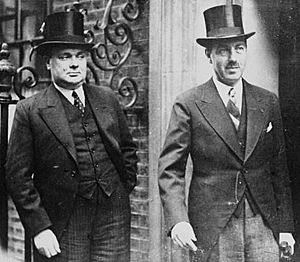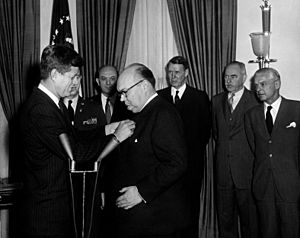Paul-Henri Spaak facts for kids
Quick facts for kids
Paul-Henri Spaak
|
|
|---|---|

Spaak, pictured in 1957
|
|
| Prime Minister of Belgium | |
| In office 20 March 1947 – 11 August 1949 |
|
| Monarch | Leopold III |
| Regent | Prince Charles |
| Preceded by | Camille Huysmans |
| Succeeded by | Gaston Eyskens |
| In office 13 March 1946 – 31 March 1946 |
|
| Monarch | Leopold III |
| Regent | Prince Charles |
| Preceded by | Achille Van Acker |
| Succeeded by | Achille Van Acker |
| In office 15 May 1938 – 22 February 1939 |
|
| Monarch | Leopold III |
| Preceded by | Paul-Emile Janson |
| Succeeded by | Hubert Pierlot |
| 2nd Secretary General of NATO | |
| In office 16 May 1957 – 21 April 1961 |
|
| Preceded by | Hastings Ismay |
| Succeeded by | Dirk Stikker |
| President of the Common Assembly (European Coal and Steel Community) |
|
| In office 11 September 1952 – 11 May 1954 |
|
| Preceded by | Office established |
| Succeeded by | Alcide De Gasperi |
| President of the United Nations General Assembly | |
| In office 31 March 1946 – 20 March 1947 |
|
| Preceded by | Office established |
| Succeeded by | Oswaldo Aranha |
| Personal details | |
| Born |
Paul-Henri Charles Spaak
25 January 1899 Schaerbeek, Belgium |
| Died | 31 July 1972 (aged 73) Braine-l'Alleud, Belgium |
| Political party | Belgian Workers' Party Belgian Socialist Party |
| Alma mater | Free University of Brussels |
Paul-Henri Charles Spaak (born January 25, 1899 – died July 31, 1972) was an important Belgian Socialist politician and diplomat. He is known as one of the "founding fathers" of the European Union. He worked with other leaders like Robert Schuman, Alcide De Gasperi, and Konrad Adenauer to create the organizations that later became the EU.
Paul-Henri Spaak came from the well-known Spaak family. He was briefly a soldier in World War I and was captured. After the war, he became a tennis player and a lawyer. He was famous for defending an Italian student accused of trying to harm Italy's Crown Prince in 1929. Spaak was a strong socialist and joined politics in 1932. He became a minister in 1935 and then the prime minister of Belgium in 1938.
During World War II, he served as the Foreign Minister for the Belgian government in exile. In this role, he helped create the Benelux Customs Union with the Netherlands and Luxembourg. After the war, he was Prime Minister two more times. He also held other important government jobs in Belgium until 1966. He was Belgium's Foreign Minister for 18 years.
Spaak strongly believed in countries working together. He became famous for supporting international cooperation, even with countries that were not allies. In 1945, he was chosen to lead the first meeting of the General Assembly of the new United Nations. He was a big supporter of European integration, which means European countries working closely together. He helped create the Benelux agreement in 1944.
He was the first President of the Consultative Assembly of the Council of Europe from 1949 to 1950. He also became the first President of the European Coal and Steel Community (ECSC) from 1952 to 1954. In 1955, he led the "Spaak Committee" which looked into creating a common market in Europe. He played a key role in preparing the 1957 Treaty of Rome, which created the European Economic Community (EEC). He received the Charlemagne Prize that same year. From 1957 to 1961, he was the second Secretary-General of NATO.
Paul-Henri Spaak retired from Belgian politics in 1966 and passed away in 1972. He is still seen as a very important person in European politics. Many things are named after him, like a foundation, a building at the European Parliament, and a negotiation method.
Contents
About Paul-Henri Spaak's Family
Paul-Henri Spaak was born on January 25, 1899, in Schaerbeek, Belgium. He came from a well-known Belgian family called Spaak. His family had moved to Belgium from Sweden in the 1600s.
His grandfather, Paul Janson, was an important member of the Liberal Party. His mother, Marie Janson, was a socialist and the first woman to be in the Belgian Senate. His father, Paul Spaak, was a poet and writer. His uncle, Paul-Emile Janson, was also a Prime Minister of Belgium. His niece, Catherine Spaak, became a movie star.
Paul-Henri Spaak and his wife, Marguerite Malevez, had two daughters and one son. Their daughter, Antoinette Spaak, was the first Belgian woman to lead a political party. Their son, Fernand Spaak, became a diplomat. After Marguerite passed away in 1964, Paul-Henri married Simone Dear in 1965. His brother, Charles Spaak, was a screenwriter.
Early Life and Learning
During World War I, Spaak tried to join the Belgian Army. However, he was captured by the Germans and spent two years in a prisoner of war camp. After the war, he was released and went to the Université Libre de Bruxelles to study law. Around the same time, Spaak was also a talented tennis player. He played for the Belgian team in the 1922 Davis Cup.
After finishing his law degree, Spaak worked as a lawyer in Brussels. He was known for defending people accused of crimes.
Belgian Politics After World War I
Spaak joined the Socialist Belgian Labour Party in 1920. He was elected as a representative in 1932. In 1935, he became the Minister of Transport in Paul Van Zeeland's government. In 1936, he became the Minister of Foreign Affairs. He served under Van Zeeland and then under his uncle, Paul-Émile Janson.
From May 1938 to February 1939, he was Prime Minister for the first time. During this period, some important social changes happened in Belgium.

- A law in 1938 helped increase the number of affordable homes.
- Rules were set for applying a 1936 law about paid holidays to farm workers.
- The 1936 paid holidays law was updated to include all workers, even those who worked from home. It also removed the rule that workers had to be with the same employer for a year to get a holiday.
- Benefits for miners who were old, sick, or had lost family members were increased.
- Rules were made to improve safety at work, like banning certain fuels for cleaning hands.
- Working hours in the ship-repairing industry in Antwerp were set at 42 hours per week.
- The eight-hour workday law was extended to include technical staff in cinemas.
As Minister of Foreign Affairs from 1936 to 1940, Spaak kept Belgium neutral. This meant Belgium did not formally join military alliances with France or the United Kingdom, and was not openly against Germany. On May 10, 1940, Germany invaded Belgium, Luxembourg, the Netherlands, and France. The Belgian Army surrendered, which caused a disagreement with some government members, including Spaak, who wanted to keep fighting.
The Belgian government moved to France. Some members, including Spaak and Prime Minister Hubert Pierlot, wanted to stay in France. Others wanted to go to London to continue the war effort. Eventually, Spaak and Pierlot traveled through Spain and Portugal in difficult conditions, arriving in London in October 1940.
Belgian Policies After World War II
After the war, Spaak was again the Minister of Foreign Affairs. He also served as Prime Minister twice.
- First, for a very short time from March 13 to March 31, 1946.
- Then, from March 1947 to August 1949.
During his second post-war government, two important housing laws were passed.
- The De Taeye Act of 1948 offered tax breaks and loans for social housing.
- The Brunfaut Act of 1949 helped organize government housing policies and shifted some costs to the state.
- A law in 1947 said that homeowners whose houses were damaged in the war could get money to repair them.
In 1948, women in Belgium gained the right to vote. Laws were also passed to create works councils and a fund for school buildings. The multilateral school system was also introduced in 1948.
Many changes were made to improve working conditions in mines:
- In September 1947, it became mandatory to have mine safety services and health committees in all mines.
- Rules for hygiene, medical exams, rescue, and first aid were updated.
- Rules for using explosives in non-mine workplaces were put in place.
- From 1948, 95% of wages were automatically adjusted for inflation.
- Women were allowed to become judges from 1948.
In December 1948, a law changed the National Society for War Orphans to include all orphans, widows, and family members of war victims. From June 1947, young workers under 18 got three weeks of paid leave, and those between 18 and 21 got at least two weeks. In June 1948, holiday pay for workers was doubled. In August 1948, a law introduced non-religious moral education in secondary schools.
Foreign Policies and International Work
Spaak was again Foreign Minister from April 1954 to June 1958, and from April 1961 to March 1966. Even though he was a Socialist, he sometimes disagreed with his party on issues like Atlanticism (cooperation with North America), recognizing Franco's Spain, and language issues in Belgium. During his last time as Foreign Minister, Belgium granted independence to Burundi.
Working with the United Nations
Spaak became well-known internationally in 1945. He was chosen to lead the first meeting of the United Nations General Assembly. During a UN meeting in Paris in 1948, he famously told the Soviet Union's delegation, "peur de vous" (meaning "fear of you").
Building Europe

After 1944, Spaak strongly supported countries working together and ensuring collective safety. While he was in exile in London, he pushed for a customs union between Belgium, the Netherlands, and Luxembourg, which became Benelux. In 1948, he helped organize a meeting in The Hague that pushed for the creation of the Council of Europe.
In August 1949, he was elected President of the Council of Europe's Consultative Assembly. He worked hard to build connections between governments and encourage steps towards a political body to unite Europe. However, by 1951, he realized the Council of Europe wasn't ready for a truly united Europe. He resigned, but he kept pushing for European integration.
Soon, he found a new way to work towards his goal. From 1952 to 1953, he led the Common Assembly of the European Coal and Steel Community (ECSC). This organization eventually grew into the European Union.
Spaak believed that linking the coal and steel industries of France and Germany was just the first step. His next goal was to expand this idea to a much wider economic group, which could then become a political union. In 1955, European leaders at the Messina Conference asked him to lead a committee. This committee, called the "Spaak Committee," was tasked with preparing a report on creating a common European market.
The "Spaak Report" became the basis for the 1956 conference at Val Duchesse. This led to the signing of the Treaties of Rome on March 25, 1957. These treaties created the European Economic Community (EEC) and the European Atomic Energy Community (Euratom). Paul-Henri Spaak signed the treaty for Belgium. His work in creating the EEC earned him a place among the founding fathers of the European Union.
Leading NATO
In 1956, NATO chose Spaak to be its new Secretary General. He held this important job from 1957 until 1961. He often disagreed with French President Charles de Gaulle. Spaak publicly criticized de Gaulle for blocking NATO's progress and slowing down efforts for European and Atlantic cooperation. De Gaulle strongly believed in national independence and did not trust the United States.
Spaak used all his diplomatic skills, but his opinions did not always change the minds of the main leaders in NATO. When France tried to block Britain from joining the European Communities in 1962, Spaak worked with Joseph Luns of the Netherlands to stop this idea. He strongly defended the independence of the European Commission. He famously said, "Europe of tomorrow must be a supranational Europe," meaning a Europe where countries give up some power to a central European body. The first building of the European Parliament in Brussels is named after him. When France left NATO's military command in 1966, Spaak helped choose Brussels as the new headquarters.
On February 21, 1961, US President John F. Kennedy gave Spaak the Medal of Freedom.
Later Life and Passing
Paul-Henri Spaak retired from politics in 1966. He was a member of the Royal Belgian Academy of French Language and Literature. In 1969, he published his memories in two books called Combats inachevés, which means "The Continuing Battle."
Spaak passed away at age 73 on July 31, 1972, at his home in Braine-l'Alleud, near Brussels. He was buried there.
Paul-Henri Spaak's Legacy
Paul-Henri Spaak was often called "Mr. Europe." He was featured on a special Belgian gold coin in 2002, along with Robert Schuman and Konrad Adenauer. These three are known as the "three pioneers of European unification."
In a poll for "The Greatest Belgian," Spaak ranked 40th in the Flemish version and 11th in the Walloon version.
Awards and Honors

National Honors (Belgium)
- Minister of State
- Member of the Royal Academy
- Grand Cordon in the Order of Leopold
- Knight Grand Cross in the Order of the Crown
Foreign Honors
- Order of Pope Pius IX (Holy See)
- Legion of Honour (France)
- Order of Merit of the Federal Republic of Germany (Germany, 1956)
- Grand Cross of the Order of Merit of the Italian Republic (Italy, 1956)
- Order of the Companions of Honour (United Kingdom, 1963)
- Honorary Knight Grand Cross of the Order of St Michael and St George (United Kingdom, 1937)
- Order of the Netherlands Lion (Netherlands)
- Grand Cross of the Order of Christ (Portugal, 1955)
- Grand Cross of the Order of the White Lion (Czechoslovakia, 1947)
- Order of Vasa (Sweden)
- Order of the Dannebrog (Denmark)
- Order of St. Olav (Norway)
- Grand Cross of the Order of the Falcon (Iceland, 1963)
- Order of the Oak Crown (Luxembourg)
- Order of George I (Greece)
- Order of the Yugoslav Crown (Kingdom of Yugoslavia)
- National Order of the Cedar (Lebanon)
- Order of the Liberator (Venezuela)
- Order of the Crown (Iran)
- Order of the Rising Sun (Japan)
- Order of the White Elephant (Thailand)
- Grand Officer of the Order of Merit (Central African Republic)
- National Order of the Leopard (Zaire)
- Order of Vytautas the Great (Lithuania)
- Order of the Republic (Tunisia)
- Grand Cross of the Order of the Southern Cross (Brazil)
- Order of the White Rose of Finland (Finland)
- Order of San Carlos (Colombia)
- Order of Carlos Manuel de Céspedes (Cuba)
- National Order of the Ivory Coast (Ivory Coast)
Academic Honors
- Fellow of the American Academy of Arts and Sciences (1950)
Other Awards
- Charlemagne Prize (1957) from the city of Aachen for his work in uniting Europe.
- Medal of Freedom in silver with palm from U.S. President John F. Kennedy.
- Featured on Euro gold and silver commemorative coins (2002).
See also
 In Spanish: Paul-Henri Spaak para niños
In Spanish: Paul-Henri Spaak para niños
- Spaak method of negotiating
- Paul-Henri Spaak building
- Paul-Henri Spaak Foundation


